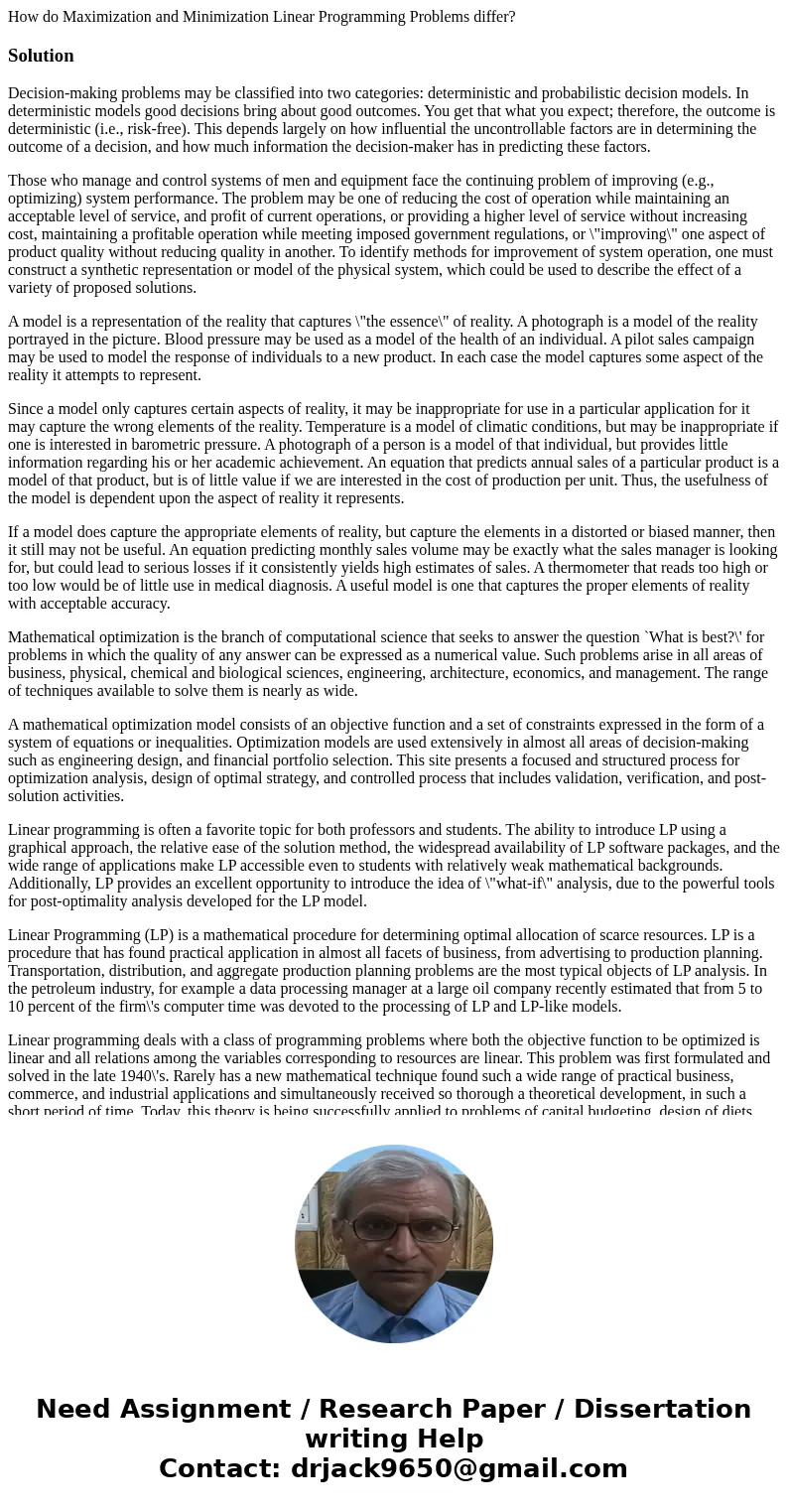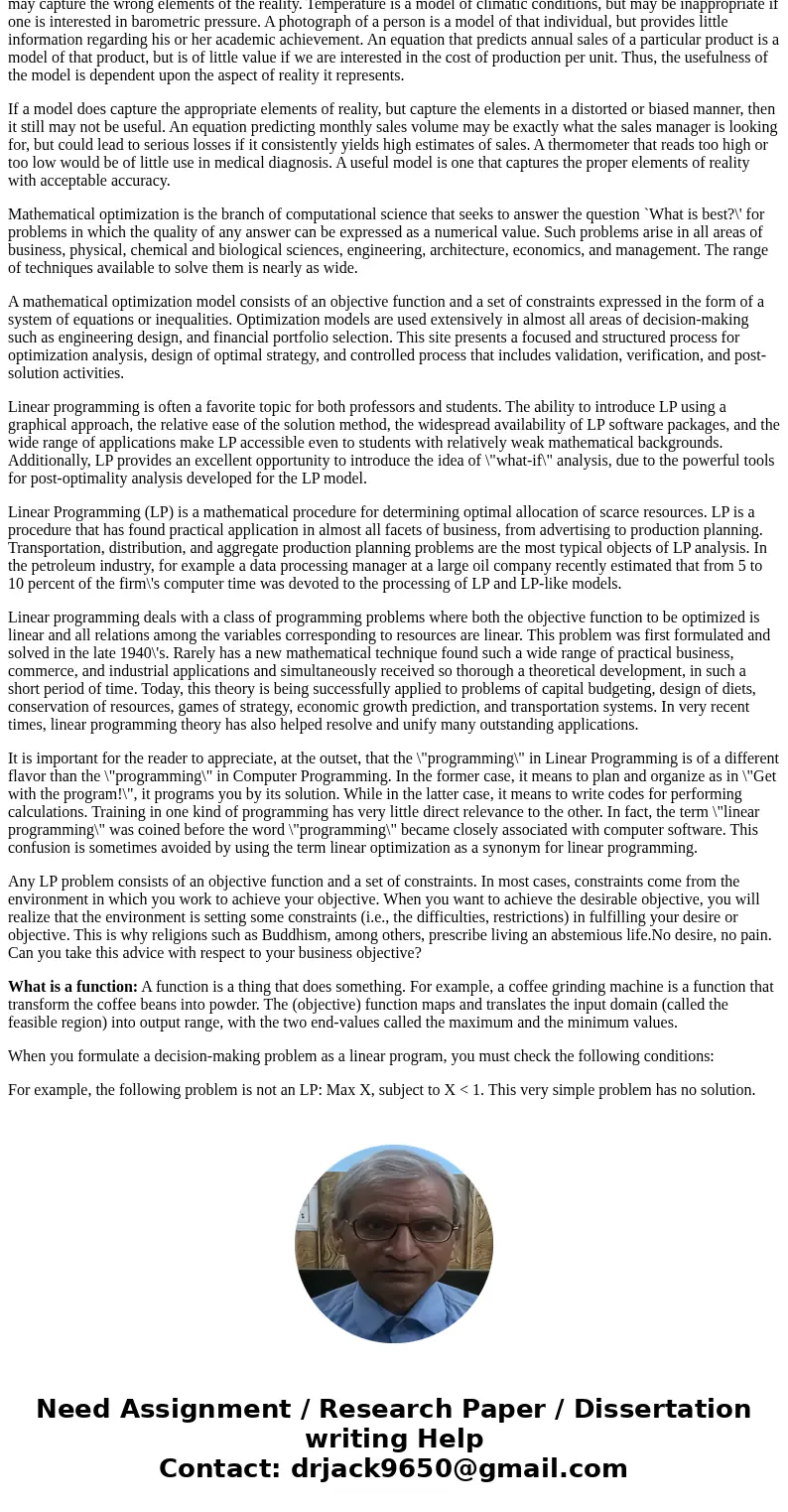How do Maximization and Minimization Linear Programming Prob
How do Maximization and Minimization Linear Programming Problems differ?
Solution
Decision-making problems may be classified into two categories: deterministic and probabilistic decision models. In deterministic models good decisions bring about good outcomes. You get that what you expect; therefore, the outcome is deterministic (i.e., risk-free). This depends largely on how influential the uncontrollable factors are in determining the outcome of a decision, and how much information the decision-maker has in predicting these factors.
Those who manage and control systems of men and equipment face the continuing problem of improving (e.g., optimizing) system performance. The problem may be one of reducing the cost of operation while maintaining an acceptable level of service, and profit of current operations, or providing a higher level of service without increasing cost, maintaining a profitable operation while meeting imposed government regulations, or \"improving\" one aspect of product quality without reducing quality in another. To identify methods for improvement of system operation, one must construct a synthetic representation or model of the physical system, which could be used to describe the effect of a variety of proposed solutions.
A model is a representation of the reality that captures \"the essence\" of reality. A photograph is a model of the reality portrayed in the picture. Blood pressure may be used as a model of the health of an individual. A pilot sales campaign may be used to model the response of individuals to a new product. In each case the model captures some aspect of the reality it attempts to represent.
Since a model only captures certain aspects of reality, it may be inappropriate for use in a particular application for it may capture the wrong elements of the reality. Temperature is a model of climatic conditions, but may be inappropriate if one is interested in barometric pressure. A photograph of a person is a model of that individual, but provides little information regarding his or her academic achievement. An equation that predicts annual sales of a particular product is a model of that product, but is of little value if we are interested in the cost of production per unit. Thus, the usefulness of the model is dependent upon the aspect of reality it represents.
If a model does capture the appropriate elements of reality, but capture the elements in a distorted or biased manner, then it still may not be useful. An equation predicting monthly sales volume may be exactly what the sales manager is looking for, but could lead to serious losses if it consistently yields high estimates of sales. A thermometer that reads too high or too low would be of little use in medical diagnosis. A useful model is one that captures the proper elements of reality with acceptable accuracy.
Mathematical optimization is the branch of computational science that seeks to answer the question `What is best?\' for problems in which the quality of any answer can be expressed as a numerical value. Such problems arise in all areas of business, physical, chemical and biological sciences, engineering, architecture, economics, and management. The range of techniques available to solve them is nearly as wide.
A mathematical optimization model consists of an objective function and a set of constraints expressed in the form of a system of equations or inequalities. Optimization models are used extensively in almost all areas of decision-making such as engineering design, and financial portfolio selection. This site presents a focused and structured process for optimization analysis, design of optimal strategy, and controlled process that includes validation, verification, and post-solution activities.
Linear programming is often a favorite topic for both professors and students. The ability to introduce LP using a graphical approach, the relative ease of the solution method, the widespread availability of LP software packages, and the wide range of applications make LP accessible even to students with relatively weak mathematical backgrounds. Additionally, LP provides an excellent opportunity to introduce the idea of \"what-if\" analysis, due to the powerful tools for post-optimality analysis developed for the LP model.
Linear Programming (LP) is a mathematical procedure for determining optimal allocation of scarce resources. LP is a procedure that has found practical application in almost all facets of business, from advertising to production planning. Transportation, distribution, and aggregate production planning problems are the most typical objects of LP analysis. In the petroleum industry, for example a data processing manager at a large oil company recently estimated that from 5 to 10 percent of the firm\'s computer time was devoted to the processing of LP and LP-like models.
Linear programming deals with a class of programming problems where both the objective function to be optimized is linear and all relations among the variables corresponding to resources are linear. This problem was first formulated and solved in the late 1940\'s. Rarely has a new mathematical technique found such a wide range of practical business, commerce, and industrial applications and simultaneously received so thorough a theoretical development, in such a short period of time. Today, this theory is being successfully applied to problems of capital budgeting, design of diets, conservation of resources, games of strategy, economic growth prediction, and transportation systems. In very recent times, linear programming theory has also helped resolve and unify many outstanding applications.
It is important for the reader to appreciate, at the outset, that the \"programming\" in Linear Programming is of a different flavor than the \"programming\" in Computer Programming. In the former case, it means to plan and organize as in \"Get with the program!\", it programs you by its solution. While in the latter case, it means to write codes for performing calculations. Training in one kind of programming has very little direct relevance to the other. In fact, the term \"linear programming\" was coined before the word \"programming\" became closely associated with computer software. This confusion is sometimes avoided by using the term linear optimization as a synonym for linear programming.
Any LP problem consists of an objective function and a set of constraints. In most cases, constraints come from the environment in which you work to achieve your objective. When you want to achieve the desirable objective, you will realize that the environment is setting some constraints (i.e., the difficulties, restrictions) in fulfilling your desire or objective. This is why religions such as Buddhism, among others, prescribe living an abstemious life.No desire, no pain. Can you take this advice with respect to your business objective?
What is a function: A function is a thing that does something. For example, a coffee grinding machine is a function that transform the coffee beans into powder. The (objective) function maps and translates the input domain (called the feasible region) into output range, with the two end-values called the maximum and the minimum values.
When you formulate a decision-making problem as a linear program, you must check the following conditions:
For example, the following problem is not an LP: Max X, subject to X < 1. This very simple problem has no solution.


 Homework Sourse
Homework Sourse